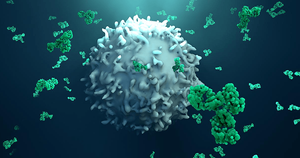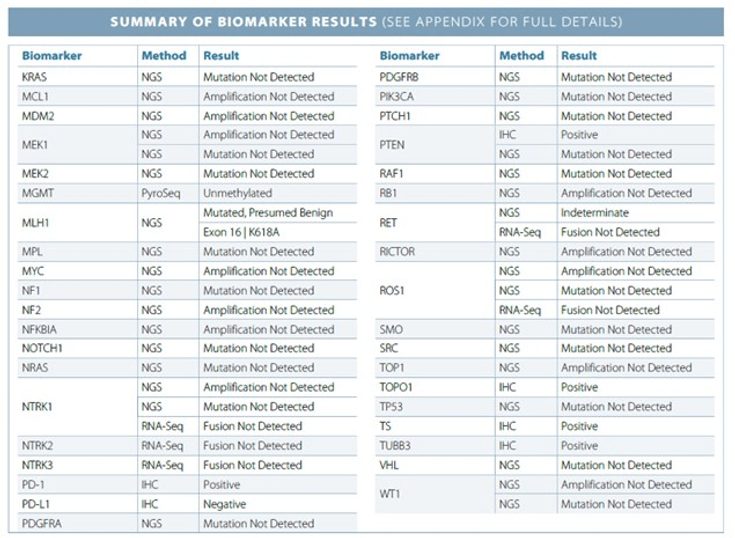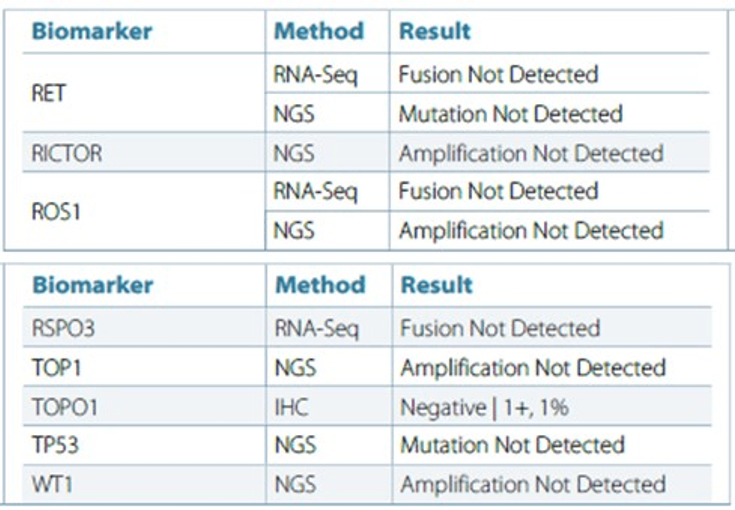Glioblastoma
Introduction
- Virtual Molecular Tumor Board
- Patient: Glioblastoma
- Levine Cancer Institute
- Presented by: Dr. Ashley Sumrall
Initial Diagnosis and Treatment
A 46-year-old man presented to the ED in Mexico with a 6-week history of left-sided numbness and tingling, slurred speech and increasing facial weakness. He underwent a CT scan with and without contrast that demonstrated a right frontal parietal mass with vasogenic edema. He was placed on levetiracetam, and arrangements were made to have him transported back to the United States for neurosurgical evaluation.
- December 2015: Frontal craniotomy with stereotactic volumetric resection of tumor using microsurgical technique
- Unmethylated glioblastoma (WHO grade 4)
- IDH1 and IDH2 negative
- 1p/19q negative
- Tissue sent for molecular testing
- January 2016 to February 2016: Radiation therapy (60 Gy/30 fractions) with concurrent temozolomide (Temodar, Merck)
- March 2016: Possible pseudoprogression noted
- April 2016: Stable scan
- May 2016: Initiate…
To continue reading
Log in or register to continue reading. It's free!
OR
By signing up to create an account, I accept Healio's Terms of Use and Privacy Policy.
Introduction
- Virtual Molecular Tumor Board
- Patient: Glioblastoma
- Levine Cancer Institute
- Presented by: Dr. Ashley Sumrall
Initial Diagnosis and Treatment
A 46-year-old man presented to the ED in Mexico with a 6-week history of left-sided numbness and tingling, slurred speech and increasing facial weakness. He underwent a CT scan with and without contrast that demonstrated a right frontal parietal mass with vasogenic edema. He was placed on levetiracetam, and arrangements were made to have him transported back to the United States for neurosurgical evaluation.
- December 2015: Frontal craniotomy with stereotactic volumetric resection of tumor using microsurgical technique
- Unmethylated glioblastoma (WHO grade 4)
- IDH1 and IDH2 negative
- 1p/19q negative
- Tissue sent for molecular testing
- January 2016 to February 2016: Radiation therapy (60 Gy/30 fractions) with concurrent temozolomide (Temodar, Merck)
- March 2016: Possible pseudoprogression noted
- April 2016: Stable scan
- May 2016: Initiate maintenance temozolomide, planned 6 to 12 cycles
- October 2016: Progressive disease
Clinical Progress and Treatment
- October 2016: Redo right frontal craniotomy with stereotactic volumetric resection of tumor using microsurgical technique
- Recurrent high grade glioblastoma with regions of necrosis (estimated approximately 10% to 15% of tumor area)
- Tissue sent for molecular testing (again)
- November 2016: Reviewed possible next therapies
- Traditional chemotherapy with bevacizumab (Avastin, Genentech)
- Single-agent bevacizumab (not preferred as he has minimal fluid attenuated recovery [FLAIR] changes and no bulky disease)
- Immunotherapy: Nivolumab (Opdivo, Bistol-Myers Squibb) off label
- December 2016: Began treatment with nivolumab
- January 2017: Scans show what was likely mixed progression/response, and patient developed subtle focal seizures. Given one dose of bevacizumab to assist with swelling from immunotherapy. No longer interested in surgery. Continuing nivolumab.
- March 2017: Recent scans show response to immunotherapy. Will continue on nivolumab with additional bevacizumab when needed. No seizures.
- April 2017: Continued to do well clinically; however new scan showed pathologic enhancement in the right temporal and right frontal parietal regions. Perfusion MRI was performed, and the findings were suspicious for tumor progression. Increased FLAIR changes noted also. Bevacizumab 10 mg/kg given again.
- May 2017: Follow-up brain MRI shows decrease in the extent of enhancement associated with a large multilobular lesion centered in the right frontal lobe glioblastoma treatment bed, and surrounding T2 hyperintensity unchanged. No evidence of neoplastic progression in the interval, but enhancing lesion remained suspicious for recurrent malignancy, particularly with the abnormal associated perfusion parameters seen on the most recent comparison MRI.
- Patient is continuing with cycle 6 of nivolumab therapy.
- Patient remains clinically stable. He continues to work and is ambulatory. He has mild short-term memory and concentration impairments.
Brain Imaging – Radiation and Temozolomide



Brain Imaging – Maintenance Temozolomide




Brain Imaging – Surgery

Brain Imaging – Nivolumab




Pathology – Part 1
- December 2015


Biomarker Testing Results - Part 1
- December 2015
Pathology - Part 2
- October 2016


Biomarker Testing Results - Part 2
- October 2016
Discussion
- This patient’s case illustrates a difficult case of recurrent glioblastoma in an otherwise healthy man.
- He underwent maximal safe resection after his initial diagnosis, then began standard chemoRT in a reasonable window of time.
- Despite being unmethylated for O6-methylguanine-DNA methyltransferase (MGMT), his initial post-chemoRT MRI showed possible pseudoprogression. The patient looked well clinically. We decided to pursue adjuvant temozolomide with close observation.
- He was stable until October 2016 (completed seven cycles of temozolomide).
- Repeat resection confirmed recurrence, and only 10% to 15% of tissue was necrotic. It was unclear if this necrosis was due to tumor or treatment effect.
- There was value in repeating molecular testing as PD-1 and PD-L1 status changed.
- Amplification of epidermal growth factor receptor (EGFR) was noted in both the 2015 and 2016 tumor samples. This occurs in approximately 40% of patients with glioblastoma.
- The EGFR variant III (EGFRvIII) was detected. It occurs in nearly half of the tumors that have EGFR amplification. It is associated with increased proliferation of glioma cells.
- In a prospective study by Montano and colleagues, patients with EGFRvIII- mutated tumors exhibited longer OS. In paired samples from primary and recurrent glioblastoma, EGFRvIII expression was approximately two-fold lower than in primary glioblastoma.
- This patient’s tumor tested positive for PD-1 via immunohistochemical screening in 2015, but not in 2016.
- There are limited trials for immunotherapy for recurrent glioblastoma, so we elected to propose using a checkpoint inhibitor via an off-label, compassionate-use program.
- Because the patient’s tumor was positive for PD-1, we elected to try nivolumab. The medication was given in a similar fashion to the now-closed CheckMate-143 trial (NCT02017717), dosed every 2 weeks.
- The central nervous system (CNS) has been described as an “immune privileged” organ because of the intact blood–brain barrier (BBB), lack of same lymphatic system as the rest of the body, and lower levels of T cells.
- This theory has been studied at length and challenged by researchers who feel that the CNS works in tandem with the immune system. In 2015, a CNS lymphatic system was discovered. Additional work demonstrated that T cells can migrate through cerebrospinal fluid-filled channels.
- The idea of an intact BBB is also known to be false in glioblastoma. There is increased permeability of BBB by tumor, surgical intervention, medications such as dexamethasone and inflammation. This further allows the immune system to influence CNS behavior.
- After a complex cascade of antigen presentation, activated T cells travel to the CNS to interact with tumor cells. This is regulated by PD-1 and PD-L1 inhibition.
- PD-1 is induced and is presented on activated T cells. PD-1 inhibitors such as nivolumab inhibit this process, allowing for more glioblastoma tumor cell destruction.
- Preclinical models supported the theory, and some therapies promoted long-term survival in animal models of glioma. This led to several clinical trials studying PD-1 inhibition in recurrent and newly diagnosed glioblastoma.
- One caveat of therapy with checkpoint inhibition is that they do not have the same pattern of response as seen with conventional chemotherapeutic or targeted agents. Response may begin as the appearance of initial increase in disease and/or T2 changes on MRI.
- These changes may represent a treatment response that will evolve into a true response. This led to iRANO, modified Respone Assessment in Neuro-Oncology (RANO) criteria for patients receiving immunotherapy.
- Meanwhile, while awaiting a response, patients may become more symptomatic. Recognizing that the skull is a confined place, intracranial edema must be managed. Typically, medicines such as dexamethasone and/ or bevacizumab are used when this happens.
- CheckMate-143 (NCT02017717) was the first randomized clinical trial in glioblastoma with a PD-1 checkpoint inhibitor.
- Preliminary results from this trial show that nivolumab for initial recurrence of glioblastoma did not meet its primary endpoint of improved OS over bevacizumab monotherapy.
- There are two first-line glioblastoma clinical trials, CheckMate-498 (NCT02617589) and CheckMate-548 (NCT02667587), evaluating the combination of nivolumab with radiation therapy with or without temozolomide in (MGMT) unmethylated and methylated patients.
References
- Carson MJ, Doose JM, Melchior B, et al. CNS immune privilege: hiding in plain sight. Immunol Rev, 213:48-65, 2006.
- Huang J, Liu F, Liu Z, et al. Immune Checkpoint in Glioblastoma: Promising and Challenging. Front Pharmacol, 8:242, 2017.
- Keller S, Schmidt MHH. EGFR and EGFRvIII Promote Angiogenesis and Cell Invasion in Glioblastoma: Combination Therapies for an Effective Treatment. Int J Mol Sci, 18, 2017.
- Louveau A, Smirnov I, Keyes TJ, et al. Structural and functional features of central nervous system lymphatic vessels. Nature, 523:337-41, 2015.
- Montano N, Cenci T, Martini M, et al. Expression of EGFRvIII in glioblastoma: prognostic significance revisited. Neoplasia, 13:1113-21, 2011.
- Okada H, Weller M, Huang R, et al. Immunotherapy response assessment in neuro-oncology: a report of the RANO working group. Lancet Oncol, 16:e534-42, 2015.
- Preusser M, Lim M, Hafler DA, et al. Prospects of immune checkpoint modulators in the treatment of glioblastoma. Nat Rev Neurol, 11:504-14, 2015.
- Razavi SM, Lee KE, Jin BE, et al. Immune Evasion Strategies of Glioblastoma. Front Surg, 3:11, 2016.
- Xue S, Hu M, Iyer V, et al. Blocking the PD-1/PD-L1 pathway in glioma: a potential new treatment strategy. J Hematol Oncol, 10:81, 2017.












